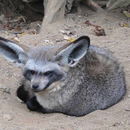en
names in breadcrumbs


Bat eared foxes (Otocyon megalotis) are rare canids.They’ve pretty muchabandonedtheir mammalian prey in favour of an insectivorous diet.The most outstanding feature of this small, tawny mammal is its huge ears in relation to its body.These ears make it possible to home in on sounds of insect activity.Their teeth are adapted for their diet too.Bat eared foxes have many small teeth, approximately46 – 50, great for munching on critters.
Bat eared foxes are mainlynocturnaland rest in their burrows during the day.Their diet consists of mostly insects (harvester termites and beetles) but in the absence of insects, they also feed on birds, eggs, non-insect arthropods, lizards and small mammals.Insects not only fulfil their nutrient intake but fulfil their water requirements as well.
Bat eared foxes form social groups similar to our own – consisting of a mating pair and their offspring.Adult foxes are usuallymonogamousand breed annually resulting in 2 – 5 cubs born between October and January.Both parents are highly invested in rearing its young.Fatherswill guard the pups at the den while their mother is out foraging.Individuals in the group engage often in social grooming and play.They will also sleep together in the den.After reaching full maturity, most offspring disperse at the start ofbreeding season.
According to theIUCN, bat eared foxes are classified as a species of Least Concern.
For more information on MammalMAP, visit the MammalMAPvirtual museumorblog.